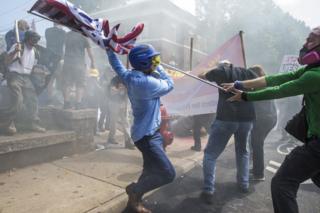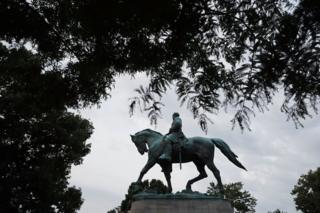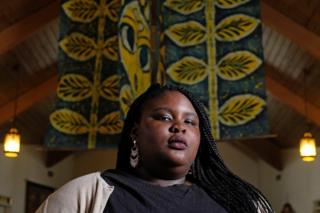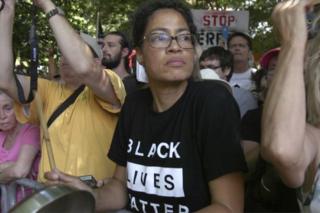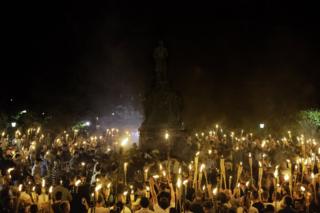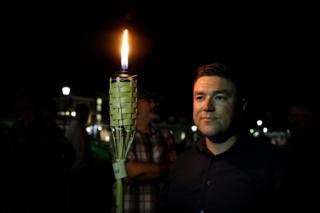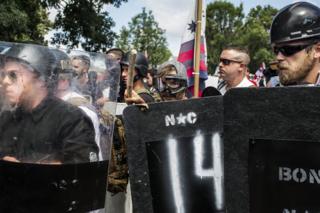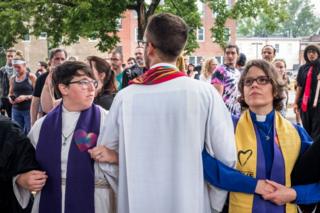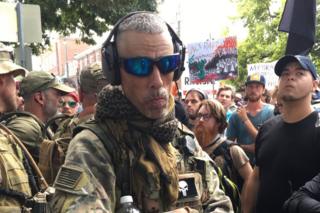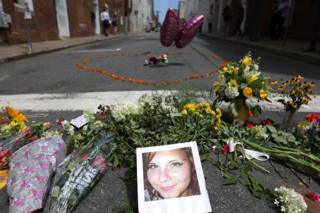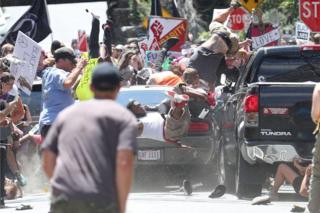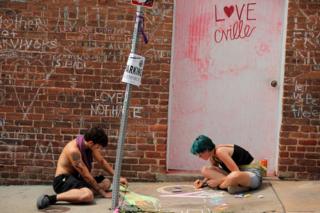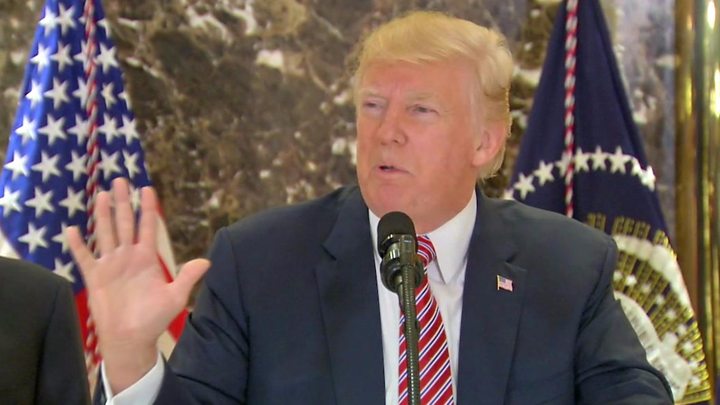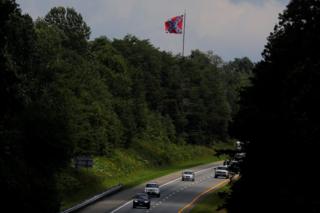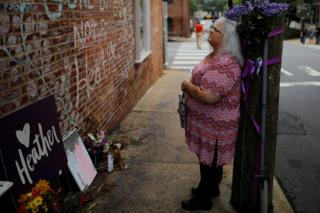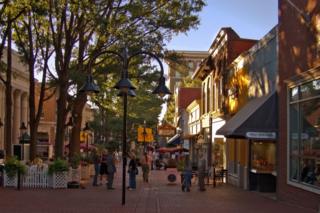‘A battle for the soul of America’
On 12 August, the small, serene city of Charlottesville, Virginia will mark the anniversary of a deadly white nationalist rally that shocked the nation.
The violence that day cost the life of a young counter-protester and scarred Charlottesville. An official report condemned city officials for failing to adequately prepare and police for standing by as confrontation turned to chaos.
In the year since, some residents have attempted to reckon with the legacy of that weekend and the racial inequality that persists in the city. Others have sought to consign the violence of last summer to the past, in an effort to restore to Charlottesville a lost reputation as a peaceful, progressive place – 2014’s official Happiest City in America.
Here, in their own words, some of those closest to the events of that weekend tell the story of what happened, why it happened, and what it meant to a city and a nation. You may find some language offensive.
PROLOGUE: ‘WE KNEW WE WERE IN FOR A BAD DAY’
Ryan Kelly, photographer, Charlottesville Daily Progress It’s important to understand that this didn’t happen in a vacuum, it didn’t just pop up and surprise everybody. It felt over the course of the summer that things were building up in Charlottesville.
Brennan Gilmore, Charlottesville resident People hadn’t quite understood the level of violence or hatred or the numbers of people coming to town, but the town was very much aware. It was like a hurricane was coming.
Jalane Schmidt, University of Virginia professor, Black Lives Matter activist The propaganda that the alt-right had put out was martial in its imagery. It was a march on Charlottesville. It was very militaristic. We felt like we were going to be under siege.
Dr Michael Williams, surgeon, UVA hospital We got a plan in place in anticipation, but I got a fair amount of push-back from my colleagues in surgery. They said “This is going to be a big nothing.”
Seth Wispelwey, local minister It felt to me like a profound test. But there was no question about where I belonged and what I wanted to do.
Brenda Brown-Grooms, local minister We’d been monitoring the social media posts of the alt-right and they were detailing their hopes for the weekend, hopes for inciting a race war in the country, so we knew it was going to be dire.
Jalane Schmidt The crazy thing is we tried to warn the city. We had infiltrated chat rooms, taken screenshots. We made six dossiers, presented them to police, the city council, anyone who would listen. We said, “This is not a First Amendment rally. They are literally coming to kill us.”
Emily Gorcenski, local activist There were explicit calls for violence there. We presented them to the city in the hope they would shut the rally down before it began.
Rev Brenda Brown-Grooms The information we gave them fell on deaf ears.
Emily Gorcenski When that failed, we knew we were in for a bad day.
‘NAZIS STARTED COMING OUT OF THE WOODWORK’
How it began – Many cities in America contended with their Confederate monuments and the legacy of slavery, but it would be Charlottesville, near the former capital of the Confederacy, that would bear the brunt of the controversy.
Jalane Schmidt In 2016 a young teenage activist here in Charlottesville started a petition to remove the Confederate monuments. At the same time, we had the Republican primary campaign heating up with Trump winning more and more states. Local white supremacists got upset about the efforts to remove the statues and they were fuelled by the feedback nationally, saying “This is OK, it’s open season to be racist.”
Zyahna Bryant, teenage activist I had to write a school paper about something I could change and I had been thinking about public spaces in Charlottesville. I thought it was important to draw attention to how Confederate imagery is violent and what it represents for people of colour. Eventually I turned my paper into a petition.
Wes Bellamy, Charlottesville councillor and former deputy mayor When I first started talking about moving the statues, people were livid, they hated hearing about it. I started getting racist abuse – “We’re going to get you nigger,” that kind of thing.
Zyahna Bryant For me, it’s hard because there are no statues in Charlottesville that depict African-American heroes. And so for that reason alone, black people have nothing to look up to in our public spaces. We are not represented.
Jalane Schmidt Those statues were put up in the 1920s in order to edify the white public and they are still there for the edification of white people. And now people are shifting the reason. Now it’s because they don’t want to forget history?
Charles Weber, Charlottesville lawyer fighting the removal of the statues Our view was that the city didn’t have the authority to do what they proposed to do. Aside from being magnificent works of art and places of beauty for the city, the statues are a memorial to war veterans. It’s not in America’s DNA to deny its own history.
Jalane Schmidt On 29 January 2017, the mayor called a press conference in front of the city hall. And he announced that Charlottesville was now the capital of the resistance. People cheered. That resonated with a lot of people, but it put a target on our backs.
Wes Bellamy The Nazis and Confederates started coming out of the woodwork. Then Jason Kessler came to light.
Jason Kessler, organiser, Unite the Right rally I wasn’t really involved in local politics, I didn’t find Charlottesville politics or any other politics very interesting. Then I was doing yard work one day for a friend and he happened to bring up the Robert E Lee statue and how the city was trying to tear it down. I thought it was symbolic of a lot of things happening in society.
Claire Gastañaga, executive director, ACLU Virginia Jason Kessler applied for a permit for a rally at Emancipation Park, some time last spring. The way the Charlottesville process works, a permit is granted automatically if there’s no negative decision in 10 days.
Jason Kessler Shoot, the moment I put in the application didn’t feel that eventful. After 10 days it was approved and I set about calling different people in the alternative media, on the internet. Some describe them as alt-right, some as alt-light.
Charles Weber Jason Kessler and Richard Spencer, both University of Virginia graduates, saw the argument over the statues as a way to promote their own cause. We were horrified by that.
Nikuyah Walker, counter-protester, now Charlottesville mayor People like Kessler and Spencer started to get a little leery of whether white supremacy would be maintained. That’s what this was about: “How dare you, a primarily white council, vote to take down our statues?”
Jason Kessler Richard Spencer is a white nationalist. Personally I don’t call myself a white nationalist. I consider myself a civil and human rights advocate, focused on the caucasian demographic.
Isaac Smith, former ally of Jason Kessler Kessler’s idea was to try to unite the alt-right with the mainstream right, and get regular Republicans to show up.
Jason Kessler The moderate speakers did not want to be on the same stage as Richard Spencer, so it ended up being much more far right than I intended it to be.
Claire Gastañaga, executive director, ACLU Virginia People had been calling all that week for Kessler’s permit to be revoked. After a series of closed meetings, Charlottesville council sent him a letter saying it was revoked but they would consider reissuing it if he moved the rally to a different location. He tweeted us at about 2am on the Tuesday before the weekend, asking if we would be interested in giving him legal assistance. There was nothing about his political positions that we agreed with, but there are rules and governments have to follow those rules. We filed a complaint on Thursday and the judge held a hearing on the Friday night, about 9pm, and ruled that the decision to revoke Kessler’s permit was an unconstitutional decision based on the content of his speech. So the permit was reissued.
Walt Heinecke, University of Virginia professor We decided to apply for permits for counter-protests. I teach a class in citizenship so I thought it was time for me to put my money where my mouth was. We are in a battle for the soul of America at this point, and I thought it was time for people to step up.
‘SUDDENLY THE FIELD WAS ALIGHT’
Friday night – White nationalist ralliers gather at Nameless Field in Charlottesville and march through the University of Virginia Campus carrying torches and chanting racist slogans. At a statue of Thomas Jefferson, they are met by student activists who link arms around the statue’s base.
Emily Gorcenski, local activist We were expecting a torch march at some point. Jason Kessler is a local and we know how he operates. And there’s only a few locations something like that could go down. At some point on Friday morning we heard it would be after dark at the university campus.
Walt Heinecke, counter-protest organiser About 9.45pm I was walking over to St Paul’s Church, and as I stood on the corner of the park I saw Jason Kessler, Richard Spencer, and a bunch of other people walk by.
Alexis Gravely, UVA student reporter Me and the managing editor had been tipped off that something was going to happen on campus. We went down there and found a lot of people with unlit torches. They were kind of in the shadows and you couldn’t tell who was who, but it was shocking to see how many people were there. I turned around to listen to Jason Kessler speak and when I turned back suddenly the field was alight. It was like it had happened in an instant.
Jason Kessler Lighting torches is a protest tactic that has been used by all kinds of different people. To think that the KKK invented marching symbolically with torches is outrageous. The way it was explained to me was that it was a funeral march for the fallen dead of our European ancestors.
Brennan Gilmore, Charlottesville resident There was an interfaith service across the road at St Paul’s and my whole family was there. My one-year-old nephew started crying inside so we went outside and fell asleep, and when we woke up there were white nationalists marching past.
Jalane Schmidt, Black Lives Matter activist The preacher came in to the church and said there were Nazis outside with torches, there were hundreds of them and they were marching on the church. There was a lot of confusion. We thought maybe they were coming to the church to torch it. I heard “You will not replace us, Jews will not replace us.” Seeing them, by the hundreds, the torches bobbing, it was horrifying.
Dr Michael Williams, UVA surgeon We were made aware that university police were responding to an unexpected assembly, 150-200 people carrying torches.
Rev Brenda Brown-Grooms We were on lockdown at St Paul’s, and when I finally got out I was sitting on the brick wall on the corner, and I saw this line of lights coming towards me. I thought “Oh God, these people can’t come right up here.”
Walt Heinecke, counter-protest organiser An activist came by and said “Your students are surrounded by Nazis.” I ran over there with a friend and what I noticed was there was no police presence, and there were 150 or so Nazis, fascists with torches, screaming racial epithets. Student activists were around the Jefferson statue, locking arms peacefully, chanting “Black Lives Matter”.
Emily Gorcenski There was a moment when I saw them marching towards us that I would describe as the worst thing I’ve ever felt in my life. It was absolute terror.
Alexis Gravely, UVA student reporter One of the things that struck me was the organisation – they were calling for men over 200 pounds to stand on the outside for security, things like that. It was loud, it was chaotic, it was booming in your ears.
Rev Brenda Brown-Grooms I could see and smell the torches. And unfortunately, as a person of colour in this country, I don’t have to go back far to remember those things, to remember feeling totally unprotected, unheard, unseen, and unwanted.
Wes Bellamy, former deputy mayor There was a sense of anger that these cowards would march with torches and surround 20 college kids and try to intimidate them. That really showed me who those individuals were. And it let me know how serious it was.
Walt Heinecke I waded into the crowd of Nazis with the dean of students and we were assaulted – I got pepper-sprayed, the dean got a torch thrown at him, the students and counter-protesters were being beaten by these guys.
Rev Brenda Brown-Grooms We had been on lockdown in the church. Eventually police arrived over the road at the campus and people began to disperse. We filed out of the back door to avoid the nationalists in the street.
Dr Michael Williams, UVA surgeon That was the first clue that our worst fears might come to pass. My feeling for Saturday was “Oh God, this is really happening.”
‘WE SAW A WAVE COMING OVER THE HILL’
Saturday morning – Local religious leaders fan out across Charlottesville, some to lead prayer services and some to stand on the front line at Emancipation Park. As the morning progresses and the temperature rises, white nationalists and counter-protesters pour into the streets around the park.
Rev Brenda Brown-Grooms We had a sunrise service at six in the morning, at First Baptist Church, Main. It was hot as blazes, as it is wont to be in Charlottesville in August.
Christian Yingling, Pennsylvania Light Foot Militia We had what I call a pre-op briefing which we have before events, where we lay out the plan for the guys for the day. We were nervous. I could see it in the guys, the way they were gearing up. They knew it wasn’t going to be good. When we first got to the park, about 7.30am, it was tense.
Brennan Gilmore, Charlottesville resident As soon as I got downtown I knew Charlottesville had completely transformed.
Rev Seth Wispelwey About 8am, those of us called to the front line – about 50 in all – marched from First Baptist church on Main Street to Emancipation Park. For two and a half hours, we sang, prayed, and tried to diffuse tension. We bore witness as groups of men began to march in and the temperature started to rise.
Ezé Amos, freelance photographer At first, everybody was singing and walking peacefully. As we walked there was a gentleman standing there with a white T-shirt. I knew the uniform and took a few photos and made him look up, and I got a nice clean shot of his face. He turned out to be the driver of the car.
Ryan Kelly, photographer, Daily Progress I got to Emancipation Park at 9am. The rally wasn’t scheduled to begin til noon but there were already hundreds of people arriving at the park. There was so much rhetoric around the media, but I’m a white male so I didn’t have it that bad. Ezé is from Africa, he was much more of a target.
Ezé Amos I saw the first wave of alt-right guys march up, led by Eli Mosley. They said some things to me, called me a nigger. An alt-right guy in a Hitler and swastika T-shirt punched me in the face in front of the police. The police did absolutely nothing.
Rev Seth Wispelwey We were linking arms at the entrance to the park, just like John Lewis and his people did in Selma. We saw a wave coming over the hill, and I thought “This is what we prepared for.”
Christian Yingling, Pennsylvania Light Foot Militia The alt-right filed in carrying clubs and shields. They had their baseball batting helmets, chanting “White is right”, screaming “History not heritage” and things like that.
Rev Seth Wispelwey They battered through the line of clergy. Then about 500 members of the League of the South and the National Socialist Movement – literal Nazis – came over the crest of Market Street.
Christian Yingling Everybody came together at the same point in the street out in front of the park. The city of Charlottesville knew who was coming to town, they did their homework, so why would you funnel group after group, right and left, right through each other? It made no sense.
Ryan Kelly There were barriers in the park to keep people separate but as people went in everyone got mixed up with everyone else. People were throwing bottles, there was pepper spray burning people’s eyes.
Claire Gastañaga, ACLU Virginia I was on the corner of Second and Market St. It was clear there was no effort to separate the two sides – there was almost permission to engage in violence.
Brennan Gilmore It was pretty clear to me it was not going to end well. The place was awash with weapons and you didn’t know who was legitimate security or who was from a militia.
Christian Yingling Thirty-two guys walking down the street in full body armour with semi-automatic weapons, sure, it’s going to intimidate people. Was that our intention? No. We are a really community-minded organisation and we are trying to get out of that stereotype that militias are fat guys hiding out in the woods waiting for the government.
Ryan Kelly, photographer, Daily Progress The militia groups claimed they were just maintaining the peace, but they were all wearing camo and military gear and carrying rifles and handguns. It added to the sense of hostility.
Emily Gorcenski, local activist The militia didn’t do anything to keep the peace. I think they wanted to stand there and roleplay.
Christian Yingling, Pennsylvania Light Foot Militia The reason for us to be there had nothing to do with white supremacy – I completely disagree with their message. But they had the right to say whatever they wanted, and the counter-protesters had that right too, and that’s why we were there.
Emily Gorcenski When you look at what these militia groups are saying, it’s very rarely in the defence of black people, for example. It’s very rarely in the defence of liberals or progressives or socialists. It only seems to be in defence of forces in our society that continue to oppress minorities.
Rev Brenda Brown-Grooms I was at the First United Methodist Church. We kept being locked down in the building. There were Nazis shouting outside, Antifa trying to combat them. People in the church were trying to sing over the din. The helicopters were hovering overhead, their rotor blades wapping. We looked at one another and started praying hard.
Dr Michael Williams As the only physician here at UVA who was involved in 9/11 – I was in DC – the feeling of dread I had was exactly the same. That feeling you were being targeted from the outside by people who were outright evil.
Rev Brenda Brown-Grooms There was a narrative that people came to town to stir up trouble, but we have to take that back. Certainly people came to town, but they were also already here. They live here. I see them all the time.
Ryan Kelly There were hundreds, if not thousands, of people around the park at this point. It was tough to keep track.
Rev Seth Wispelwey There were roving groups of men, most in polo shirts, many carrying sticks, bats, all in the street. What was surreal was seeing all the monuments around the city surrounded by hundreds of people intending to cause violence. When we got face to face with these white supremacists, all the slurs were anti-Semitic, homophobic, misogynistic – we didn’t hear anything anti-black or anti-Muslim. It was even more primitive.
Christian Yingling Over five and a half hours, we had bricks thrown, people being hurt by clubs, paint and faeces tossed at my people. The majority were from hate groups – they came organised, they had a plan, you could tell by the way they marched. Antifa had their plan too, because they came with coolers full of stuff to throw at people.
Isaac Smith, former Jason Kessler ally Look at who was going to be there, you are putting large radical armed groups – actual Nazis – with actual Communists and you are giving them all guns. That was a recipe for disaster. There were definitely alt-right groups I could see were armed to the teeth. And then you also had the far-left, Redneck Revolt. Most of Charlottesville who were counter-demonstrating were peaceful, but there were a lot of out-of-towners who had wanted to punch a Nazi for their whole lives and finally they had an opportunity.
Ryan Kelly, photographer, Daily Progress It was really strange because it was all happening with this giant police presence around the outer edges of the park.
Claire Gastañaga Nobody predicted that the police would have been as incompetent as they were. It never occurred to us that they wouldn’t keep the demonstrators and counter-demonstrators separate.
Nikuyah Walker, counter-protester People were yelling at officers, asking them ‘Why didn’t you protect us, why didn’t you help us?’
Ryan Kelly It got worse and worse until the police finally stepped in and said it was an unlawful assembly, and people started to disperse.
Dr Michael Williams At the hospital we’d had a trickle of people who were faint from the heat, but in the morning we were mainly just watching the TV and listening to the radio communication. Then I heard on the police radio, “Pedestrians struck, multiple victims, potentially as many as 40.”
‘TIME JUST SEEMED TO STOP’
Saturday afternoon – At the corner of Water Street and Fourth, a white nationalist rally-goer ploughs into a crowd of peaceful counter-protesters in his car, killing 32-year-old Heather Heyer and injuring 19 others. James A Fields, 20, is later arrested and charged with murder.
Ryan Kelly, photographer, Daily Progress I was taking photos on Fourth Street and it was calm, it was the calmest I’d felt all day. It was at that exact second when a car sped past me down the street. Out of instinct I grabbed my camera.
Susan Bro, Heather Heyer’s mother Heather went off with her friends that day to say “This is our town, get out, this is what we believe, if you don’t like it, leave” and to stand strong with her friends in the community to say black lives do matter.
Brennan Gilmore, Charlottesville resident I heard the acceleration of a car behind and looked around and saw a vehicle flying down the street. It was immediately apparent what was going on by the manner he was driving. The visual was horrifying, the sound of it was revolting.
Jack Basile, gave CPR to Heather Heyer At first I thought it was an explosion, because all I could see was people flying through the air and people screaming and people running towards me. I have an audio recording and it’s hard to listen to.
Rev Brenda Brown-Grooms We were watching the live news inside the building, and we screamed when we saw the car hit. The spit fired in my mouth.
Emily Gorcenski, local activist We had been tracking threats of violence online so I knew right away it was an attack, not an accident. My thought at that moment was that he was going to pop out and start shooting at people. My instinct was to run towards the car, towards the attacker. I briefly drew my gun so I was ready in case he did come out shooting. Thankfully he didn’t.
Jack Basile I saw the car backing up the street then I saw Heather lying on her side. I reached around Heather’s head and realised instantly it was bad. Then time just seemed to stop.
Brennan Gilmore It was a terrible, terrible moment and all hell broke loose. People were lying in various states of distress, a woman collapsed in front of me. It occurred to me I had been filming it. I debated whether or not to share it, and my first instinct was not to.
Emily Gorcenski We decided at that point was to leave the scene, because some of us had guns and the best thing to do in that scenario was to get the guns out of the situation.
Jack Basile We pulled Heather out from underneath another guy and she took a deep breath and relaxed. There was a critical care nurse who had arrived beside me. I couldn’t feel a pulse, she couldn’t feel a pulse, and she said let’s start CPR. She was doing compressions and I was using a one-way valve mask to help Heather breathe. After a few minutes the police finally showed up. Then paramedics arrived and took over. I walked across the street and sat on the corner in a state of complete and utter shock.
Dr Michael Williams We were watching the news and saw the car fly through. When Heather Heyer came in, CPR was in progress and then 14 others came in. We occasionally see blunt force trauma victims, but it’s never or rarely intentional. And it’s very rare that we’d get 10 at once, from the same incident.
Susan Bro, Heather Heyer’s mother Heather’s best friend called me to tell me that the hospital was looking for the next of kin and I knew if he called me, there was something wrong because he never calls unless something’s wrong.
Dr Michael Williams People were brought in covered in swastikas and other symbols I would equate with hate. But in the moment we were just taking care of the patients. You don’t see the swastikas. I’m African-American, and afterwards, you realise you have got a person here who literally would just as sooner see you dead. But you remind yourself of why you got into the profession.
Ryan Kelly, photographer, Daily Progress It wasn’t until I looked at the pictures in full size that the gravity of it hit me. There was one photo specifically that I thought was the most telling, and that was the one we have all seen, the one that went viral and won the Pulitzer. We didn’t publish it initially. I talked to my editor and the other photographer, they went to the company and the lawyer and they said “Let’s publish it.”
Brennan Gilmore I thought that showing [what I had filmed] was necessary to tell people in Charlottesville “stay away, stay home, the stakes are fatal.” It never entered my mind that I would be targeted for sharing it. It wasn’t until a day later that I heard about the conspiracy theory, that everything I had seen was a set-up, a propaganda operation. These far-right boards had listed my family members. I went through a hellish week of being targeted by these conspiracy theorists. I had friends I’d grown up with who were accusing me.
Susan Bro I can’t begin to tell you how horrendous that day was. They walked me up to the room and the detective told me that she was pronounced dead. I just put down my head and let out an ungodly sound.
Jack Basile I had a really, really difficult time afterwards and it is still with me. I still have my press pass from that day, in a bag, and it still has blood on it.
Susan Bro After Heather died there was a period of time, probably three months at least, and it still happens occasionally, where I’d be walking through town and someone would come up to me and say “I knew Heather and she touched my life.”
Three hours after the attack, a Virginia State Police helicopter which was monitoring the rally crashed outside Charlottesville, killing Lieutenant H Jay Cullen and Trooper-Pilot Berke M M Bates.
‘THE PRESIDENT KEPT TALKING AND TALKING’
Tuesday afternoon, New York – President Trump has already made two statements on Charlottesville, first stating on Saturday, to the dismay of many watching, that there was violence “on many sides”, before delivering prepared remarks on Sunday in which he condemned white nationalism. At a press conference in New York on Tuesday, he makes his third statement on the violence.
Jordan Fabian, White House correspondent, The Hill The press conference was billed as an announcement on infrastructure and we were told he wasn’t planning on taking questions. You never know what’s going to happen with him, but we weren’t expecting him to wade back into this. He started to wrap up and a reporter shouted out a question and he answered it, and it was off to the races.
Jalane Schmidt, Black Lives Matter activist I was watching TV and I heard Trump say there were “good people on both sides”.
Jordan Fabian As he made those remarks, the atmosphere at the press conference got more and more heated. I remember, there was a lot of staff in the lobby of Trump Tower. John Kelly, Trump’s chief of staff, was off to one side rubbing his temples. I looked at Sarah Huckabee Sanders, his press secretary, and she was standing there silently. They looked shocked at how it was playing out.
Christine Emba, opinion editor, The Washington Post The hope was that surely, surely the President of the United States would say something appropriate. Say “This is not who we are.” Or “Racism is bad”, perhaps? That we are against white supremacy? The fact that he could not bring himself to do that was a shocking confirmation that we were in a newly bad place.
Zyahna Bryant, Charlottesville high school student I was in Charlottesville near downtown and I was watching him on the TV with some friends and we were all just like, what? Twitter was blowing up, Facebook and Instagram were blowing up.
Jordan Fabian Just judging from the body language, I think a lot of his staff were uncomfortable with what he was saying. Gary Cohn appeared to be gesturing to the president to wrap it up. Of course the president just kept talking and talking.
Jalane Schmidt There was dismay. To have your president say that – it was mortifying that anybody could dare make any moral equivalency between counter-protesters and these white supremacist haters bent on murder. It was just insulting.
Christian Yingling, Pennsylvania Lightfoot Militia I was standing in the kitchen and I remember the moment he said “There are good people on both sides and bad people on both sides”, and then he threw in a little nugget about the one good group that was there. That really caught my ear. I looked at my wife, “Did I just get a nod from the president?” “I think you did,” she said.
Jason Kessler, organiser, Unite the Right rally In the environment of sensationalism, and blaming only one side, it was good to hear the president mention that we had a permit. People don’t know that.
Susan Bro, Heather Heyer’s mother Trump’s office called while I was at the funeral and I had my phone turned off. I turned my phone on at 10pm and I saw that there had been three voicemails from the president’s office. They sounded increasingly frantic. I turned on the news and heard him say that there were good people on both sides and I thought, I don’t want to talk to him.
Christian Yingling It was really like any other protest – there were good people on both sides. Not all the people who went up to the park that day were white supremacists.
Isaac Smith, former Kessler ally It was relatively clumsy, but not fundamentally incorrect. There are better ways he could have made the same point.. There were people on both sides who energetically participated in violence: it’s not as simple as ‘one side attacked the other and one side defended themselves’.
Jordan Fabian, White House correspondent, The Hill If you compare to previous administrations, I don’t think there would be situation where you would have a soft-pedalling reaction to any kind of white supremacist violence. But the president had said what he said the first time, and sort of taken it back. Then when he doubled down on his first response at that press conference at Trump Tower, in such a vehement way, I think that let a lot of people know that’s what he truly felt about the situation.
Christine Emba, Washington Post As an African American person living in America, it felt like a double betrayal. First, he couldn’t bring himself to admit that it was not “both sides” – that there’s a difference between white supremacists and people pushing back against them. Then we had to wait for him to be reined in by a trained communications professional, but he still couldn’t stick to that.In the end, he said what he really wanted to say. He was addressing aid and comfort to the people he wanted to reassure, and that was white supremacists and his more racist supporters. He put himself on the side of an America we had hoped we were leaving behind.
Zyahna Bryant What he said really created a ripple effect. I’ve heard people all over, even within our community, say we have to pay attention to the violence on both sides.
Jordan Fabian I think that still a year later stands out as one of the lowest moments of President Trump’s time in office.
Christine Emba And he hasn’t done very much since to make anyone feel better. He went from that to deriding the NFL protesters who took a knee, to calling African nations shithole countries, to calling MS-13 members animals. It hasn’t gotten better.
‘AUGUST 12 WAS NOT THE BEGINNING OR END’
Today – Charlottesville has elected Nikuyah Walker, who was among the counter-protesters in August, as the city’s first black woman mayor, and many in the city see progress wrought from the wounds of that weekend. Others see a deep racial inequality laid bare but barely changed by what happened. The Confederate statues still stand, and the city has declared a state of emergency ahead of the anniversary.
Rev Brenda Brown-Grooms I was born in Charlottesville in the basement of the University of Virginia, among the lead-dripping pipes, because that’s where the coloured babies were born. I could not have been born at Martha Jefferson hospital. Even if my mother had been crowning with me she would not have been allowed in. There is an ugly truth in Charlottesville and in America, and it is the legacy of white supremacy.
Nikuyah Walker, mayor of Charlottesville Charlottesville has always been a pretty segregated area. I grew up like many black families in the community: working-class families, parents working every day, multiple jobs, attempting to make ends meet. It’s a very different experience from the Charlottesville in our brochures and the “world-class city” designation we attempt to give ourselves.
Wes Bellamy, former deputy mayor We used to think we were somehow better than the other communities and cities in which you saw overt white supremacy. Ours was always much more covert and underhanded, it wasn’t directly in your face.
Nikuyah Walker I know previous generations – my parents’ generation, grandparents – learned to stay out of the way, learned to do what you need to do to get by.
Jalane Schmidt Local white folks tend to think of this as a liberal place but black people – and I am African American – we see a lot of contradictions. The police stopping and frisking black people. The gentrification. The lack of affordable housing. The struggle to get living wage.
Zyahna Bryant, student who wrote the original statue petition There are still unspoken boundaries in Charlottesville, places where people of colour are not welcome. The downtown mall is not a very welcoming space.
Susan Bro, Heather Heyer’s mother Have things changed in Charlottesville? It depends on who you ask. If you ask a wealthy white person, the town is wonderful and it has always been wonderful. If you ask someone who is not wealthy and not white, you would get a different perspective. August 12 was not the beginning or the end of the situation here.
Zyahna Bryant August 12 was only a reflection of the history of Charlottesville and how racist it really is. August 12 is every day. A lot of people want us to move into this “August 13” phase where we move past everything, but we are still in this paralysis of August 12. We are still there.
Ezé Amos, photographer Some things have started to change, in the sense that people talk about the racial divide, inequality. More white people are being outspoken about it, which I really appreciate.
Claire Gastañaga, ACLU Virginia What happened provoked a sense that we haven’t really had the conversations about race in America that we need to have. There’s a great need for that. Whether there’s the will for it remains an important question.
Wes Bellamy We just took 120 people from Charlottesville on a pilgrimage to Montgomery, Alabama, to learn about civil rights and the history of lynching. We have finally recognised John Henry James, a man who was lynched here in 1898. We put a lynching marker up and gave him his proper due. Those things would not have happened were it not for what occurred that weekend. The legacy is not just about statues and park names, those are ultimately superficial things. There are things happening on the ground that are changing the landscape of the community.
Ryan Kelly, photographer I love this city, but what happened was a scar on Charlottesville. The fact the whole world now knows this place now because of one attack is depressing.
Rev Seth Wispelwey Outside of town, I feel Charlottesville had a really positive impact. But it’s been hard to face here because we are continuing to live under the threat of white supremacist violence.
Susan Bro The hate does not seem to disappear, it just keeps changing forms.
Walt Heinecke, counter-protest organiser The community in Charlottesville is pretty much ready for whatever happens on the anniversary.
Susan Bro Jason Kessler says he isn’t going to do anything here but I wouldn’t count on people not showing up.
Jason Kessler I was originally hoping to do something in Charlottesville but we had to drop those plans. I don’t think Charlottesville has a commitment to public safety. I think it’s better for me and the citizens of Charlottesville to have parted ways, and they can heal from whatever mental wounds they’ve had from this sordid affair and I can do the same.
Christine Emba, Washington Post I think people of colour were really affected by Charlottesville, by seeing that historical violence dredged into the present. I think many felt isolated by it. You might be surrounded by white neighbours and friends who say, “I’m so sorry for you, but we should move on,” and it’s a very isolating feeling.
Zyahna Bryant There are people here who continue to deny that racism is even a thing, or that white supremacy is a thing. But white supremacists keep coming to town. Some of them live right here in Charlottesville. We are at a point where it’s time to choose a side: either you are going to be on the right side or the wrong side of history.
Wes Bellamy I still get abuse every day. You think white supremacists are going to stop calling me nigger because of something that happened one weekend last year? Or because now I have a doctorate? Now they call me doctor nigger.
Charlottesville Police Department, the University of Virginia Police Department, Virginia State Police and Charlottesville City Council either did not respond to requests for comment or declined to comment. Interviews condensed and edited for clarity.
All pictures copyright
Source: Read Full Article
